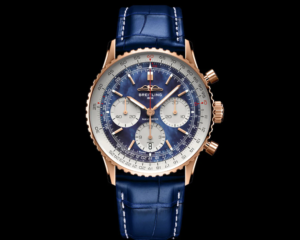I still remember the first time I laid eyes on a Breitling.
It was a quiet afternoon in Zurich, and I was wandering the Bahnhofstrasse with no real intention other than to soak in the city’s refined spirit. As I passed a boutique, something in the window caught my eye. A timepiece—sleek, bold, and unapologetically complex—glistened under the showroom lights. I stepped closer, almost involuntarily, and that’s when I read the name on the dial: Breitling.
Little did I know then that this casual glance would become the opening chapter of a long and deeply personal journey into the art and science of one of Switzerland’s most storied watchmakers. In the years that followed, I would come to understand not just what makes a replica breitling watch desirable, but what makes it authentic. And trust me—once you learn to distinguish the real from the replica, there’s no going back.
What sets Breitling apart is not just its history—though it’s impressive—but the feeling each timepiece evokes when it’s on your wrist. There’s a weight to it, literally and metaphorically. It speaks of craftsmanship, of careful human hands guiding each movement into place with reverence for the machinery. You don’t wear a Breitling merely to tell the time. You wear it to own time.

Over the years, I’ve learned that true artistry is always in the details. The dial of a genuine Breitling is a masterclass in restraint and purpose. Every index, numeral, sub-dial, and logo—flawlessly aligned, impossibly crisp. When you look closely, there’s a sense of order that feels almost… sacred.
I once had the opportunity to compare an original Breitling Navitimer to a near-identical counterfeit. At first glance, they appeared strikingly similar. But then, the truth began to emerge under scrutiny. The authentic piece had a razor-sharp logo embossed into the dial, with the iconic wings shimmering ever so slightly when tilted. The counterfeit, by contrast, had a logo that was barely etched—flat, dull, and lacking in depth.

Even the date window told a story. In the genuine Breitling, the date sat perfectly centered, framed like a portrait, changing at midnight with a clean, uninterrupted flick. The replica? The date was slightly askew and, worse, it staggered forward sometime after midnight, as though unsure of its own identity.
But while the dial might draw your eye, the heart of a Breitling lies beneath the surface—in its movement. To this day, few things feel as magical to me as the moment I hold a Breitling close and listen. There is no tick-tick-tick. Instead, there is a whir, a hum, a finely tuned symphony of gears and levers all dancing in perfect synchrony.
I remember visiting a workshop in La Chaux-de-Fonds, where a technician let me peek through the loupe at a Breitling B01 movement. “This is our pride,” he said, hands gloved, eyes bright. “In-house, 70-hour power reserve, chronometer-certified.”
And sure enough, as I watched the balance wheel oscillate with the delicacy of a dragonfly’s wingbeat, I understood. The level of finishing—Côtes de Genève, perlage, chamfering—was something no machine could replicate without the guidance of human passion.
There is a philosophy behind every Breitling that transcends mere function. These are tools, yes—but they are also heirlooms. They are meant to accompany you on transatlantic flights, deep-sea dives, boardroom battles, and perhaps one day, even to the Moon.
When I wear my Breitling Superocean, I don’t just wear a watch—I wear decades of marine exploration, of human curiosity diving deeper than ever before. When I wind my Chronomat, I’m winding the spirit of engineers who built instruments for the Italian Air Force in the 1980s.
Breitling has come a long way since Léon Breitling opened his workshop in Saint-Imier in 1884. Today, under CEO Georges Kern, the brand is evolving—focusing on sustainability, expanding its collections, and refining its aesthetic for a new generation.
Whether it’s the Navitimer with its iconic slide rule, the sleek Premier with its urban elegance, or the rugged Endurance Pro built for athletes, Breitling watches replica still speak one universal language: integrity.
They are a celebration of Swiss engineering, yes—but also of human resilience, precision, and the drive to explore.
There are many great watchmakers in the world. Each with its own legacy, its own aesthetic, its own fanbase. But for me, Breitling has always represented a unique fusion of function and philosophy. It is the watch of pilots, divers, explorers, and dreamers.
I could never wear a replica, not because it’s immoral (though that argument is valid), but because it lacks the soul. A fake is hollow—void of craftsmanship, story, and spirit. When I look at my Breitling, I see not just the time—it’s my time. My effort. My journey. My moments.
If you’re considering buying a Breitling, I urge you to do so with intention. Don’t just purchase a status symbol—invest in a legacy. Learn to spot the signs of authenticity, appreciate the detail, and connect with the story behind the watch. Take the time to try one on, feel the weight, wind the crown, and listen to its heartbeat.